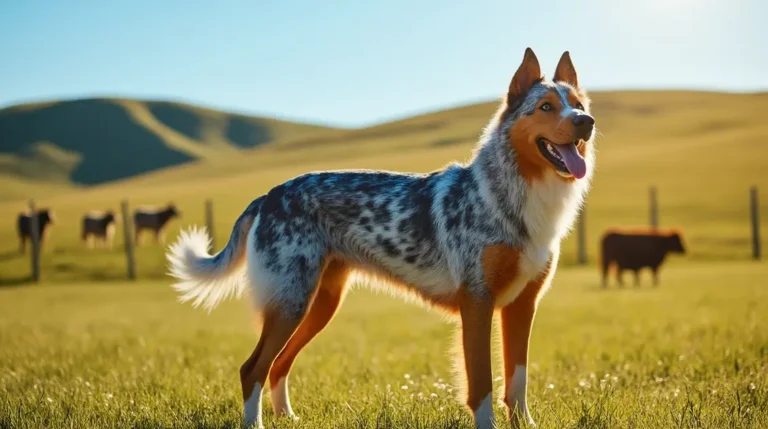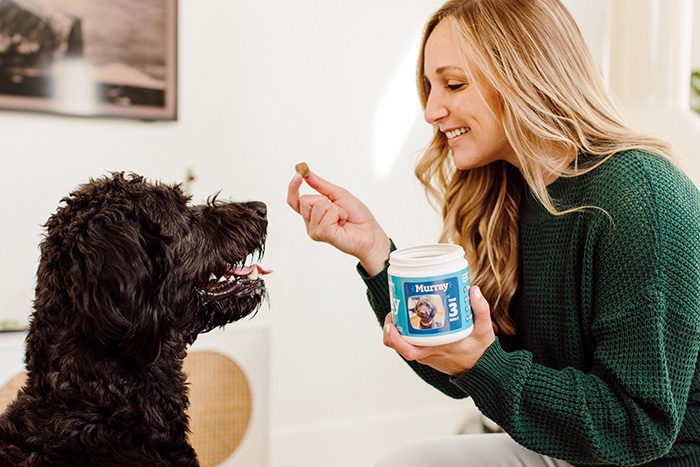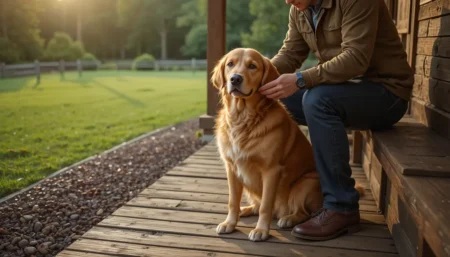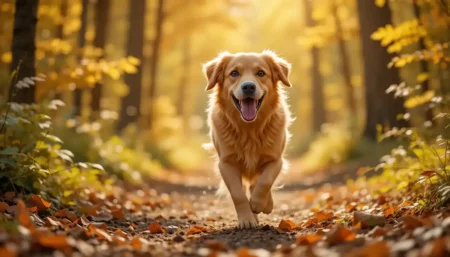The Australian Cattle Dog is a fiercely intelligent, high-energy herding breed developed in Australia to drive cattle over long distances. Known for loyalty and athleticism, this medium-sized dog requires experienced handling and intense exercise.
Discover if this dynamic breed matches your lifestyle.
History of the Australian Cattle Dog
Developed in 19th-century Australia, the Australian Cattle Dog was specifically bred to manage vast cattle stations in challenging terrain.
These dogs combined native Dingoes with imported herding breeds to create an unmatched working companion.
Their tireless stamina and problem-solving abilities made them indispensable to Australian ranchers.
Origins and Development
Early Australian settlers needed dogs capable of driving cattle across miles of rugged landscape.
They crossed native Dingoes with Collies and other herding breeds, eventually refining the Australian Cattle Dog we know today.
The breed’s development focused on endurance, intelligence, and the ability to work independently without constant direction from handlers.
Recognition and Popularity
The Australian Cattle Dog gained formal recognition from kennel clubs worldwide in the mid-20th century.
While still primarily a working dog on ranches, their intelligence and loyalty have made them increasingly popular as companions for active families. The breed remains one of Australia’s most iconic canine exports.

Physical Characteristics and Appearance
The Australian Cattle Dog presents a compact, muscular frame built for endurance and agility.
Their distinctive appearance reflects their working heritage while maintaining an alert, intelligent expression that immediately identifies them as capable herding dogs.
Size and Structure
Male Australian Cattle Dogs typically stand 18-20 inches at the shoulder, while females measure 17-19 inches.
Both sexes weigh between 33-50 pounds, creating a powerful yet agile build perfect for maneuvering around cattle.
Their structure emphasizes balance and coordination rather than sheer size, allowing them to work effectively in challenging environments.
Coat and Color Variations
Australian Cattle Dogs feature two distinct color patterns:
- Blue: Mottled blue coat, often with black, blue, or tan markings
- Red: Solid red speckled coat (sometimes called “red heelers”)
Both varieties may display distinctive tan points above the eyes, on the cheeks, and legs. Their short, dense double coat requires minimal grooming but sheds seasonally.
| Physical Characteristic | Details |
|---|---|
| Height (Males) | 18-20 inches |
| Height (Females) | 17-19 inches |
| Weight Range | 33-50 pounds |
| Coat Type | Short, dense double coat |
| Common Colors | Blue mottled, red speckled |
| Life Expectancy | 12-15 years |
Temperament and Personality Traits
The Australian Cattle Dog’s personality shines through their intense focus and unwavering loyalty.
Bred to work independently while maintaining a connection with their handler, they develop deep bonds with their families while retaining a certain independence that defines the breed.
Loyalty and Protective Instincts
Australian Cattle Dogs form exceptionally strong attachments to their families and serve as natural guardians of both people and property.
Their protective nature makes them excellent watchdogs, though proper socialization prevents excessive wariness of strangers.
This loyalty manifests as constant companionship—they’ll follow family members from room to room, always staying within sight.
Intelligence and Problem-Solving Abilities
Ranked among the most intelligent dog breeds, Australian Cattle Dogs excel at learning complex tasks and solving problems.
Their sharp minds require constant stimulation to prevent boredom-related behaviors.
Without adequate mental challenges, they may invent their own “jobs”—often involving chewing, digging, or herding children and pets around the house.
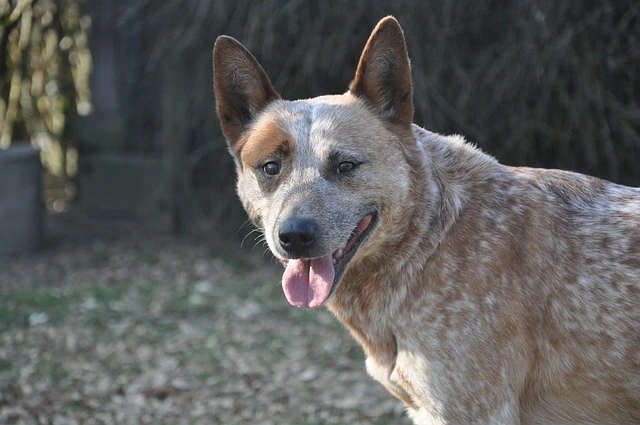
Training and Exercise Requirements
The Australian Cattle Dog’s legendary stamina demands rigorous physical and mental challenges.
Bred for endurance herding, this breed suffers without sufficient activity, often developing destructive behaviors. Here’s how to meet their unique exercise needs:
Daily Exercise Essentials
Australian Cattle Dogs require at least two hours of exercise daily, including both physical activity and mental stimulation.
They thrive on extended sessions of running, jogging, frisbee, fetch, or agility training.
Long walks, trips to the dog park, swimming, and hiking satisfy their need for movement while strengthening your bond.
Top 5 Training Tips for Australian Cattle Dogs:
- Start obedience training early with positive reinforcement methods
- Incorporate puzzle toys and scent games for mental stimulation
- Use short, varied training sessions to maintain interest
- Provide structured activities like herding trials or dog sports
- Never use punishment-based techniques—this sensitive breed responds poorly to harsh methods
Preventing Behavioral Issues
Without adequate exercise and mental challenges, Australian Cattle Dogs may develop problematic behaviors, including:
- Excessive barking
- Nipping at heels (herding instinct)
- Destructive chewing
- Anxiety when left alone
- Digging
Consistent training and sufficient activity prevent most behavioral problems. Remember that mental exercise is just as crucial as physical activity for this intelligent breed.
Common Health Concerns
While generally healthy, Australian Cattle Dogs face several breed-specific health challenges that responsible owners should monitor.
Proactive veterinary care and awareness of potential issues help ensure your dog lives a long, comfortable life.
Hereditary Conditions
Deafness represents one of the most significant health concerns for Australian Cattle Dogs, particularly in puppies with predominantly white coloring.
Regular hearing tests help identify issues early. Additionally, they’re prone to various eye diseases, including progressive retinal atrophy (PRA), cataracts, and glaucoma that can lead to vision impairment.
Joint and Metabolic Issues
Hip dysplasia and other joint problems affect some Australian Cattle Dogs, especially when obesity develops.
Maintaining a lean body condition through proper diet and exercise reduces strain on joints.
Thyroid disorders and liver conditions also occur with higher frequency in the breed compared to many others.
Preventative Care Strategies
Implement these practices to protect your Australian Cattle Dog’s health:
- Schedule annual veterinary checkups with comprehensive screenings
- Maintain ideal body weight through measured feeding and exercise
- Provide joint supplements as recommended by your veterinarian
- Test for deafness and eye conditions during puppy development
- Choose breeders who conduct health screenings on parent dogs

Daily Care and Grooming
Caring for an Australian Cattle Dog involves straightforward grooming routines combined with consistent environmental management.
Their relatively low-maintenance coat belies the significant time commitment required for proper exercise and mental engagement.
Grooming Essentials
Despite their short coat, Australian Cattle Dogs shed moderately year-round with seasonal increases.
Weekly brushing controls loose hair and distributes natural oils through their coat. Bathing should occur only when necessary, as over-bathing strips protective oils from their skin.
Regular nail trimming, ear cleaning, and dental care complete their basic grooming needs.
Environmental Considerations
Australian Cattle Dogs thrive in homes with secure fencing and ample space for activity.
They’re better suited to houses with yards than apartments, though dedicated owners in urban settings can meet their needs with rigorous daily exercise routines.
Never leave them unsupervised for extended periods—boredom leads to destructive behaviors as they seek their own entertainment.
Nutrition Guidelines
Feed your Australian Cattle Dog a high-quality diet appropriate for their age, size, and activity level.
Measure portions carefully, as obesity can significantly worsen joint problems and other health conditions.
Avoid free-feeding and monitor treats to prevent weight gain. Consult your veterinarian about appropriate dietary supplements for joint health.
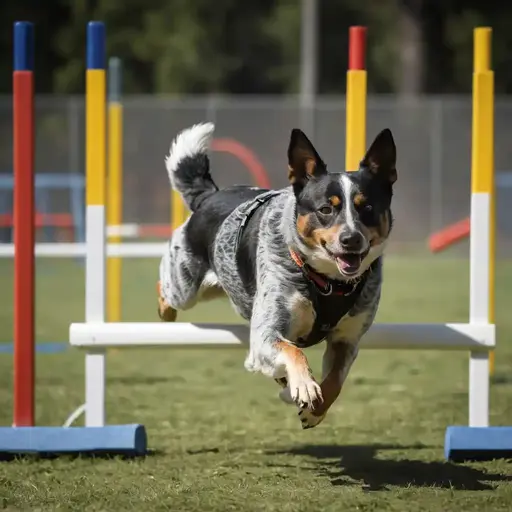
Choosing an Australian Cattle Dog Puppy
Selecting an Australian Cattle Dog requires careful consideration of your lifestyle and commitment to meeting their demanding needs.
This isn’t a breed for casual pet owners—it demands an active partner who can provide structure, training, and purpose.
Finding a Reputable Breeder
Seek breeders who prioritize health testing and temperament in their breeding programs. Responsible Australian Cattle Dog breeders:
- Screen parent dogs for deafness, eye conditions, and hip dysplasia
- Socialize puppies from an early age
- Allow you to meet the puppy’s parents
- Provide health guarantees and ongoing support
- Ask questions about your experience and lifestyle
How long do Australian Cattle Dogs typically live?
The Australian Cattle Dog enjoys a relatively long lifespan of 12-15 years when properly cared for. Their longevity stems from their working heritage and generally robust health, though they remain susceptible to certain breed-specific conditions requiring vigilant monitoring.
Avoid breeders who cannot provide health clearances or seem more interested in making a quick sale than ensuring proper placement.
Puppy Temperament Assessment
When selecting an Australian Cattle Dog puppy, observe their behavior for signs of appropriate temperament:
- Look for curiosity and confidence without excessive shyness
- Notice how they interact with littermates and humans
- Test their reaction to novel objects and sounds
- Avoid puppies showing extreme fearfulness or aggression
- Choose a puppy whose energy level matches your lifestyle
Remember that Australian Cattle Dogs mature slowly—what seems like a calm puppy may develop intense working drive as they grow.

FAQs
Are Australian Cattle Dogs good for first-time dog owners?
Australian Cattle Dogs present significant challenges for inexperienced owners due to their high energy and intelligence. They require experienced handling and consistent training. First-time owners should consider less demanding breeds unless prepared for intensive training commitment and professional guidance.
Do Australian Cattle Dogs shed a lot?
Yes, Australian Cattle Dogs shed moderately year-round with seasonal increases. Weekly brushing controls loose hair, but heavy shedding isn’t typical. Their short coat makes cleanup more manageable compared to fluffier breeds, though you’ll find hair on furniture and clothing regularly.
Can Australian Cattle Dogs live in apartments?
While possible with extraordinary effort, apartments generally don’t suit Australian Cattle Dogs. They require extensive daily exercise and mental stimulation that’s difficult to provide in confined spaces. Without sufficient outlets for their energy, they develop destructive behaviors that make apartment living problematic.
How much exercise does an Australian Cattle Dog need daily?
Australian Cattle Dogs need at least two hours of exercise daily, including both physical activity and mental challenges. This includes vigorous activities like running, hiking, or dog sports, plus puzzle toys and training sessions. They possess great stamina and will happily accept much more activity when available.
Conclusion
The Australian Cattle Dog remains one of the most capable and loyal working breeds, offering unmatched intelligence and dedication to active owners.
Their need for substantial exercise and mental challenges makes them unsuitable for sedentary lifestyles but perfect for those who enjoy outdoor activities and structured training.
Properly cared for, this remarkable breed forms an extraordinary bond with its family while maintaining its legendary work ethic.
If adopting an Australian Cattle Dog, commit to providing at least two hours of daily activity—explore dog sports like agility or herding trials to channel their energy productively and build an unbreakable partnership with your remarkable companion.
Remember that understanding and respecting their working heritage transforms potential challenges into the foundation of a deeply rewarding relationship.


